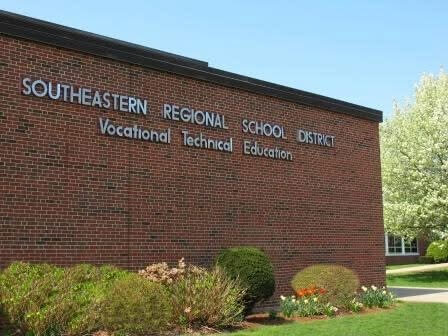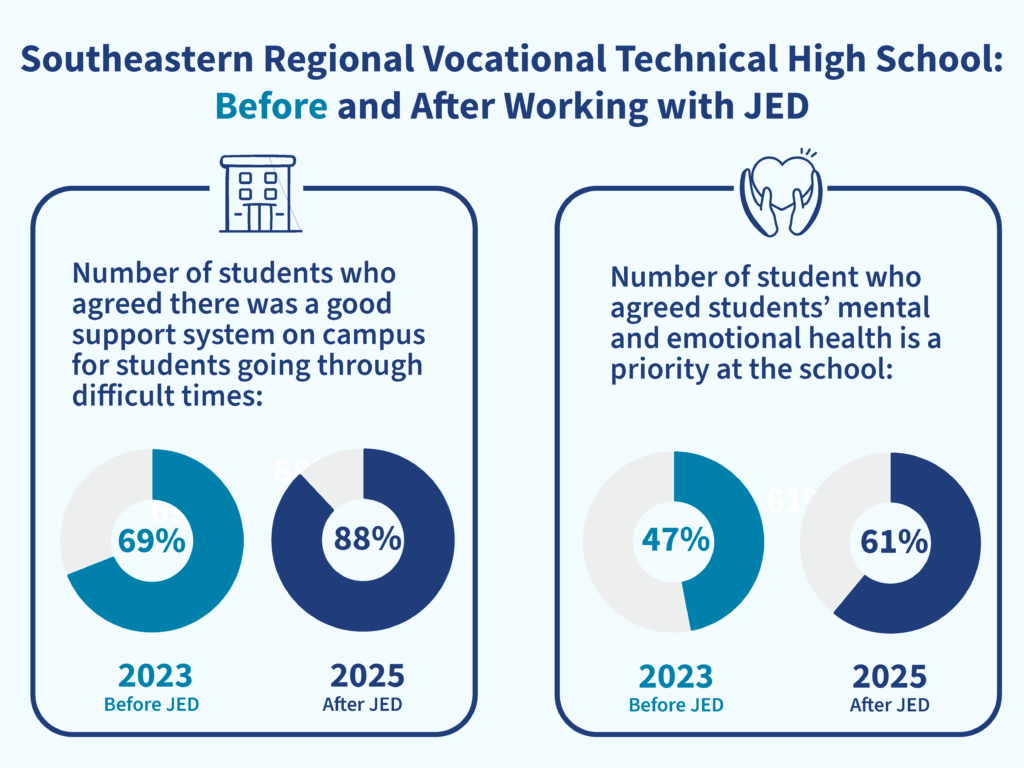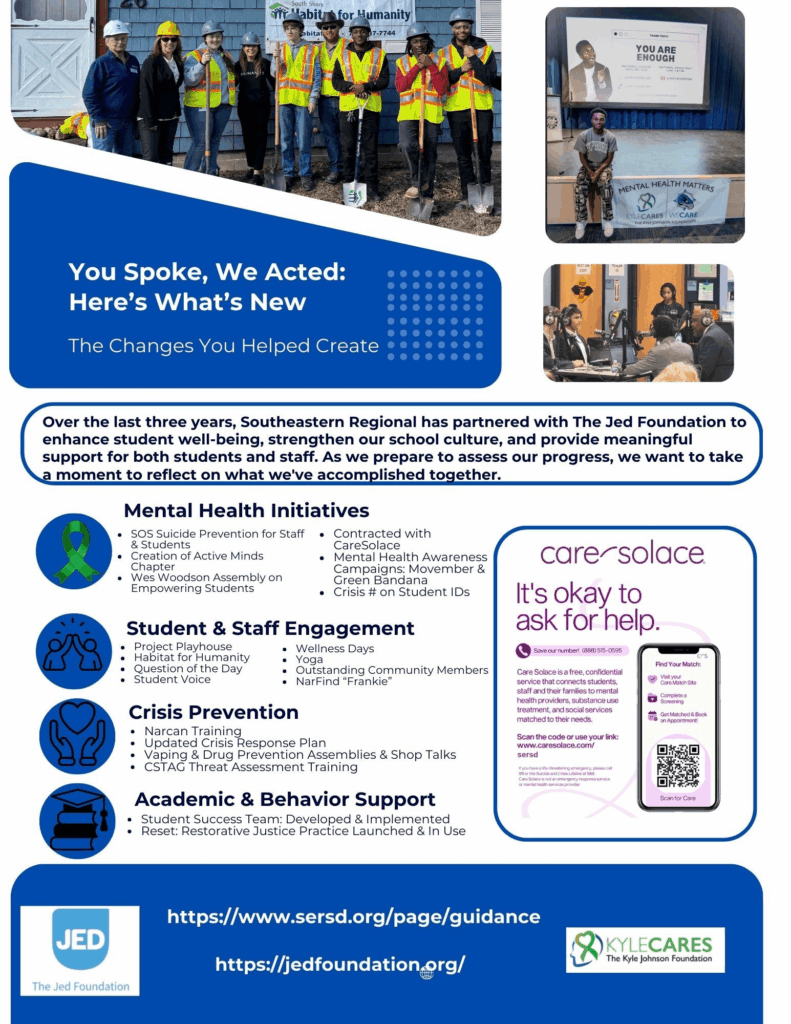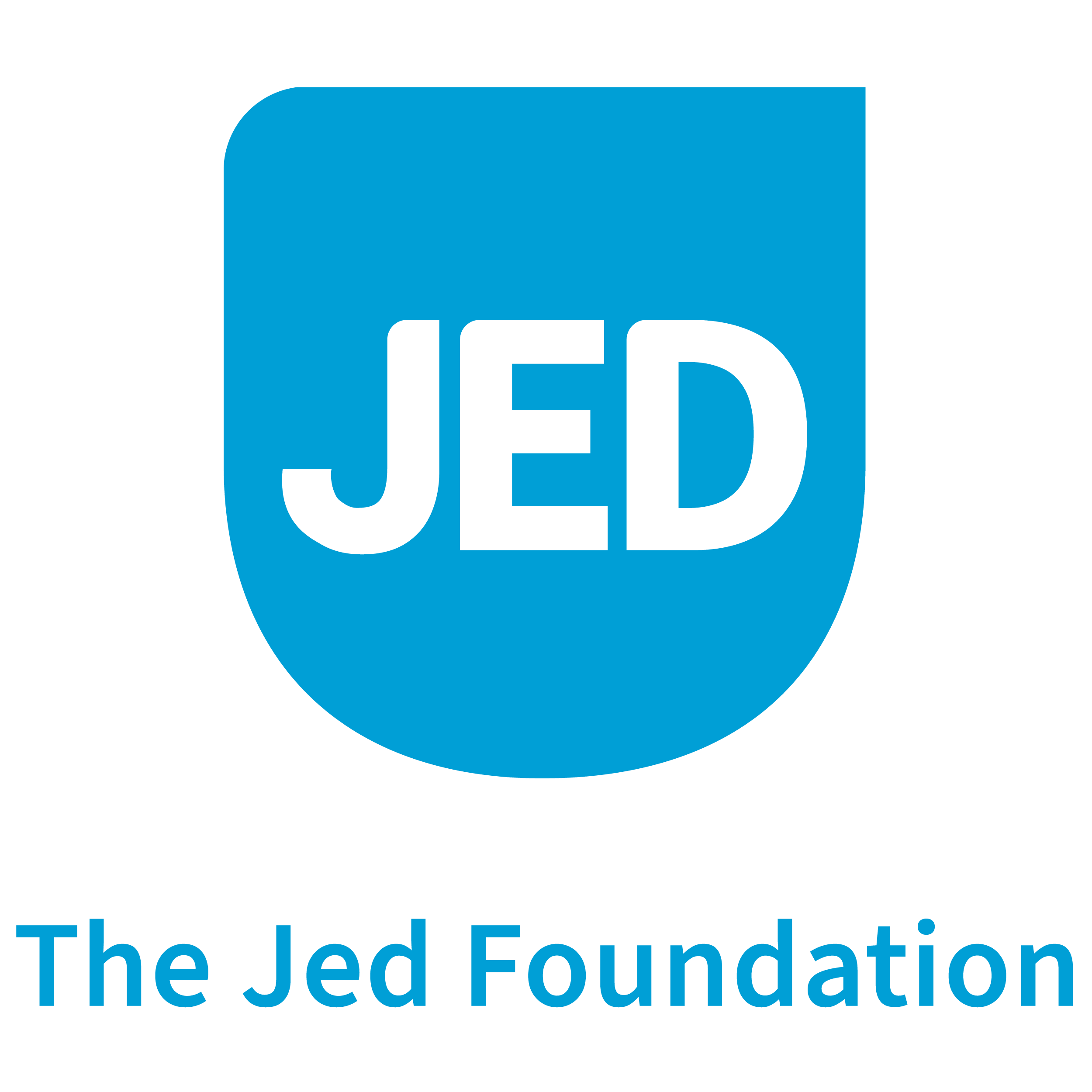
By Madeleine Burry
Lois Miller arrived at Southeastern Regional Vocational Technical High School (SRVTHS) in Easton, Massachusetts, in 2024 with classic new-job energy. “When I came to Southeastern, I thought, ‘Oh, we’re going to need to do a survey. I need to see where everything is at’,” said Miller, MS, CAGS, reflecting on her first few weeks as the director of guidance at SRVTHS.
But, to her surprise, she wouldn’t need to do a survey. SRVTHS was in the second year of the three-year JED High School Program, aiming to strengthen its mental health, substance misuse, and suicide prevention programs and systems. At the start of the partnership, The Jed Foundation (JED) surveyed teachers, students, and staff to identify and understand the current climate, needs, policies, programs, and practices surrounding student mental health.
Drawing off the survey data, JED worked with a steering committee at the school to develop a strategic plan. The plan outlined how to efficiently and effectively enhance what is already working and address unmet needs. That meant Miller came into her new role with the information she needed, and she said she was delighted to find “this great strategic plan that was already put together with all sorts of resources on not just what to do, but ideas on how to get started.” With that information, Miller was able to focus on enacting the recommendations in the plan.
At the end of the three-year engagement, JED distributed another set of surveys to document what the school accomplished, and SRVTHS’ data spoke volumes. In the original survey, 69% of students agreed there was a good support system on campus for students going through difficult times. Now 88% reported feeling that way — a 19% change. There was also a nearly 30% jump in students who agreed that mental and emotional health is a priority at the school: In 2023, 47% said it was a priority, while 61% said so in 2025.
Here’s a glimpse at how the school got there.

Gaining Motivation, Support, and Partnership With JED
At the very first in-person meeting with JED in 2023, David A. Joseph, a guidance counselor at SRVTHS, recalls reviewing results from the initial survey. “It really set the stage for what we thought JED was going to lead us through,” Joseph says.
JED reviewed the survey data and used its evidence-based framework — the Comprehensive Approach to Mental Health Promotion and Suicide Prevention for High Schools — to create a plan for SRVTHS. After reviewing the plan and considering the school’s culture and climate, SRVTHS officials chose to focus on three domains: establish and follow crisis-management procedures, encourage help-seeking behavior, and improve recognition of and response to early warning signs of distress.
“What was great about the start of the process of working with JED was that [their message was], ‘No, don’t try to touch everything all at once’,” Miller says. “You know how it is when you try to do everything at once — nothing gets done the way you want.”
Instead, Miller found that JED offered empathetic flexibility. The school was partnered with Krystal Skaggs, MS, LPC, LCDC-I, a JED School Mental Health Specialist. With a background as a mental health therapist and school counselor, as well as a long history of working in school settings, Skaggs brought an intrinsic understanding of the day-to-day challenges in public education. Miller and her steering committee met monthly with Skaggs.
“Having the check-ins was exactly what we needed to stay on the course,” Miller says.
Three Years, and Big Accomplishments
Here are some of the main accomplishments SRVTHS achieved in its three years working with JED.
Enacting a Suicide Prevention Program
“One of the big things that we really worked on was suicide prevention,” Miller says. The high school now has a standardized practice in place to respond to students in distress. All counselors and staff members have been trained in the protocol, Miller says.
The previous year, the school had a Signs of Suicide suicide-prevention training with teachers and freshmen; last year, there was training for both freshmen and sophomores.
“That was a huge accomplishment,” Miller says.
Encouraging Help-Seeking Behavior and Access to Care
To increase help-seeking behavior among students, SRVTHS implemented a program with Care Solace, a service that allows students, staff, and anyone in the school community to access referrals to a wide variety of services outside of what the school provides. That’s often therapy, Miller says, but people can also seek services for neuropsychological evaluations and other mental health support.
“When people are depressed or struggling, making all those phone calls is really difficult,” Miller says.
Developing Students’ Life Skills
There’s no denying that it’s helpful for young people to feel confident in their social skills. To that end, Miller does a question of the day each morning with students and staff.
“It’s just trying to connect with them…and it really does make an impact,” Miller says. Some questions require deep thought (those are never asked on a Monday), but often they’re simple: What’s a color you associate with July? Have you ever lived in another state? What are your go-to rainy-day activities?
Miller relies on The First Five, a resource Skaggs shared with her, which sends a daily email with questions tailored for various grades.
Turning a Spotlight on Mental Health
Over three years, the partnership has allowed the school to put more energy into improving its students’ mental wellness. The work done in the counseling department and the support available are more visible, Joseph says.
“JED helped make it feel more schoolwide, and not feel like it’s something that just counselors do in the building,” Joseph says of SRVTHS’ mental health supports.
Students have gotten involved in amplifying mental health care through awareness campaigns such as Movember and Green Bandana, and helping others through organizations such as Habitat for Humanity and Project Playhouse. Many staff members are also involved with programs related to student well-being, Joseph says. The school’s athletic department, for example, ran a program on mental health awareness.
“It makes a bigger impact if we’re all working together on it,” Miller says.

What’s Ahead for SRVTHS
Joseph hopes more teachers will get involved in various programs, especially those of vocational classes. The teachers, who come with expertise on plumbing, HVAC systems, and other trades, work closely with students, but they may not have experience identifying mental health issues or providing support.
For Miller and Joseph, there’s a glow from the accomplishments that are reflected in the survey data. “It’s exciting…getting that validation” from the survey, Miller says. “It helps with the motivation to keep moving forward in the right direction.”
Plus, there’s a clear sense of what remains to be done: Some areas of the strategic plan presented early on in the partnership haven’t yet been addressed.
“We know where we need to go, and we have a road map to get there,” Miller says.
Bring JED High School to your community and find out how you can support JED’s lifesaving work.








